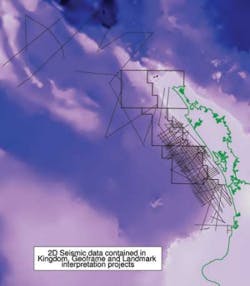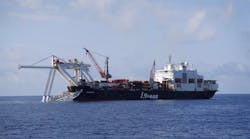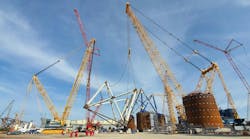Brian Green
First Subsea
TheThunder Hawk DeepDraft Semi, designed and built by SBM Atlantia, is the latest deepwater platform to come on stream in the Gulf of Mexico. The platform is anchored by a spread mooring system incorporating polyester rope supplied by Lankhorst Offshore Ropes Division (formerly Quintas & Quintas Offshore).
Murphy Exploration & Production Co. is the field operator and operates theThunder Hawk Floating Production Unit (FPU), which has a process capacity of 45,000 b/d of oil and 70 MMcf/d of gas. The semisubmersible FPU is moored on the Thunder Hawk field in Mississippi Canyon block 736, 240 km (149 mi) southeast of New Orleans in a water depth of 6,060 ft (1,847 m).
The mooring system comprises four clusters of three polyester rope-chain lines – one cluster for each corner of the FPU – which are connected to 12 driven piles by First Subsea, Ballgrab ball and taper, subsea mooring connectors. “We chose polyester rope mooring because of the water depth and the type of platform,” says Mark Slider, manager, Mooring Installation, Engineering Group, SBM Atlantia. “The FPU motions will be better for the risers with polyester rope than with steel wire rope. Polyester gives us a ‘softer’ mooring system than steel wire rope and consequently, the FPU motions are more compliant and riser friendly.”
Lankhorst Ropes and mooring specialist Offspring International supplied the polyester rope and project managed its deployment. GAMA 98 polyester rope was selected to meet the SBM requirement for a rope with a minimum breaking load (MBL) of 4,254 kips (1,930 metric tons). GAMA 98 is made up of 12 sub ropes configured with three in the center and nine arranged around the outside. It is a proven deepwater mooring rope construction in use on Chevron’sTahiti spar in the GoM, also deployed successfully on numerous other deepwater long-term and MODU projects.
Each ofThunder Hawk’s 12 mooring lines comprise two 4,230-ft (1,289-m) sections of GAMA 98 rope connected by an H-link, with a 52-ft (15.8-m) rope test insert 800 ft (244 m) beneath the FPU. Lines 4, 5 and 6 each have two test pieces giving a total of 15 rope insert test pieces. The number of test pieces is determined by the design life of the mooring system, in this case 20 years, and the number of major storms the FPU will likely be exposed to over this period.
Prior to issuing its latest Notice to Lessees and Operators (NTL) on synthetic mooring, the US Department of the Interior, Minerals Management Services (MMS), Gulf of Mexico OCS Region, required a polyester rope insert be tested routinely every five years, and following major storms. However, under the latest NTL, new facilities equipped to record environmental data and mooring tension data during major storms and hurricanes need only remove a test insert if the recorded tension in any line exceeds 70% of MBL.
Dave Rowley, director, Offspring International, sees the relaxation in the MMS requirements as part of a wider acceptance of polyester rope as a preferred deepwater tethering material beyond 4,000 ft (1,219m). “We conduct our own rigorous rope tests for every project. The MMS requirements are an important, and independent, source of on-going rope testing that further strengthens the case for polyester deepwater mooring tethers,” he says.
After a significant event, the operator has to demonstrate that the mooring ropes are still fit for purpose and one method is to test a rope insert. These tests subject a selection of sub ropes extracted from the insert to break load testing and fatigue analysis. Microscopic analysis is also used to check for yarn-on-yarn abrasion.
The mooring lines were installed by first pre-installing the Ballgrab female receptacle, connected to the anchor chain, in a docking porch on each of the piles. Once theThunder Hawk FPU was in position, the male Ballgrabs, attached to the end of each of the mooring lines, were lowered into the female receptacles.
The mooring connections were effected sequentially working counter-clockwise per cluster with a male Ballgrab connector attached to each of the four clusters. The connection was completed within a few minutes of the male connector reaching the female connector. With the first four mooring lines connected to each of the clusters, the installation sequence was then repeated for the remaining connectors.
The accuracy of the polyester rope lengths was critical to the smooth installation of the mooring lines, according to Mark Slider. “Until the advent of the new rope length measurement system developed by Lankhorst, obtaining polyester lengths with a high level of accuracy had been extremely challenging, if not impossible. However we knew from Technip’s experience onTahiti that Lankhorst was able to make long rope lengths estimated to be accurate to within a meter.
“Our experience onThunder Hawk was no different. The rope segments were the correct length which made completing and tensioning the lines straightforward,” he says. All of the Thunder Hawk mooring lines can be adjusted to take into account any polyester bedding-in that might occur during a major storm or to adjust mooring line tensions and platform location after a riser installation.







